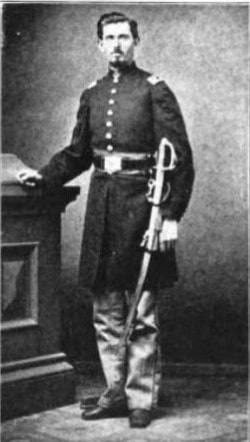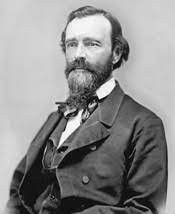
Ovando James Hollister was living in the mining district of South Clear Creek, Colorado, in the summer of 1861 when he heard that fellow miner Sam Cook was looking for volunteers to fill his company.
Born October 7, 1834 in Colrain, Massachusetts, Hollister, who went by the nickname of "Vando," had very little education as a child. He was raised within a Shaker society in eastern New York, earning his room and board as a farm laborer. Sometime in the 1850s, Hollister moved to Kansas, where he found work on a farm.
Born October 7, 1834 in Colrain, Massachusetts, Hollister, who went by the nickname of "Vando," had very little education as a child. He was raised within a Shaker society in eastern New York, earning his room and board as a farm laborer. Sometime in the 1850s, Hollister moved to Kansas, where he found work on a farm.
 Just imagine living here in the winter!
Just imagine living here in the winter!But in July 1858, gold was discovered in the Pike's Peak area of western Kansas Territory and southwestern Nebraska Territory, starting a gold rush that attracted many thousands of hopeful prospectors. By April of 1859, newspaper editors in the major Missouri River towns were reporting that between forty and 100 teams of oxen were going west each day, jamming the roads with their wagons. Hollister joined the rush. He left the Kansas farm and headed west, arriving in the Colorado mining town of Black Hawk on June 7, 1860. The 1860 Territory of Kansas, Arapahoe County (Colorado) Census states that he was living with two other young miners in Missouri City, a mining town southeast of Central City. The next year, he had moved on to South Clear Creek, Colorado.
 Samuel Cook
Samuel Cook The life of the prospector was not easy, and few of the young men who arrived in Colorado became rich. Many lived year-round in canvas tents. They cooked over open fires and lived hand to mouth. When fellow miner Samuel H. Cook learned that any man who could bring in a company of volunteers could lead the company, he plastered the area with pamphlets encouraging men to join him. In a very short period, Cook had 80 men. One of them was Hollister.
Cook intended to ride his men to Kansas, where they would serve under General James Lane. Colorado Governor Gilpin had other plans. He convinced Cook and his men that if they stayed in Colorado and joined what was to become Company F of the First Regiment of the Colorado Volunteers, they would be given horses and be well armed and equipped. Cook became the company’s captain. George Nelson, who had shared a tent and gold claim with Cook became one of the company’s lieutenants. Hollister was made sergeant.
Cook intended to ride his men to Kansas, where they would serve under General James Lane. Colorado Governor Gilpin had other plans. He convinced Cook and his men that if they stayed in Colorado and joined what was to become Company F of the First Regiment of the Colorado Volunteers, they would be given horses and be well armed and equipped. Cook became the company’s captain. George Nelson, who had shared a tent and gold claim with Cook became one of the company’s lieutenants. Hollister was made sergeant.
 Governor Gilpin
Governor GilpinAs the First Regiment’s ten companies were being formed up, Governor Gilpin was finding its leadership. He appointed John P. Slough, a lawyer who had served in the Ohio Legislature to be the Regiment’s Colonel. Samuel F. Tappan, who later became a journalist and Native American rights activist, was appointed Lt. Colonel. John M. Chivington, a Methodist preacher, was asked to serve as the Regiment’s chaplain, but turned it down, requesting a fighting commission instead. He was appointed Major and nicknamed “The Fighting Parson.”
Because Washington had provided no funding for the formation of troops, Gilpin issued his own script, which paid for uniforms, arms, supplies and equipment for the troops and for the building of Camp Weld, located about two miles from the small town of Denver. On February 14 1862, Major General Hunter ordered all the available forces that Colorado could spare to go south to aid Colonel Canby, the commander of the Department of War in New Mexico. They left on February 22, marching through snowstorms and high winds until they reached Fort Union on March 10th.
Hollister later described the hardships and frustrations of that forced winter march by the Colorado Volunteers. His account makes it clear why Colonel Slough was not beloved of his troops.
Because Washington had provided no funding for the formation of troops, Gilpin issued his own script, which paid for uniforms, arms, supplies and equipment for the troops and for the building of Camp Weld, located about two miles from the small town of Denver. On February 14 1862, Major General Hunter ordered all the available forces that Colorado could spare to go south to aid Colonel Canby, the commander of the Department of War in New Mexico. They left on February 22, marching through snowstorms and high winds until they reached Fort Union on March 10th.
Hollister later described the hardships and frustrations of that forced winter march by the Colorado Volunteers. His account makes it clear why Colonel Slough was not beloved of his troops.
The teams, relieved of their loads, took aboard a full complement of passengers, leaving, however, between three and four hundred to foot it. Away into the wee hours of morning did we tramp, tramp, tramp, --the gay song, the gibe, the story, the boisterous cheer, all died a natural death. Nothing broke the stillness of night but the steady tramp of the men and the rattle of the wagons. We were now to prove the sincerity of those patriotic oaths so often sworn, and right nobly was it done. At length the animals began to drop and die in harness, from overwork and underfeed, which forced us to stop. But for this, we would doubtless have made Union without a halt. Col. Slough rode in the coach. That never stops between Red River and Union. Why should we? Thirty miles would not more than measure this night's march, in which the men proved their willingness to put forth every exertion on demand. But feeling as they did, that there was no call for it but the Colonel's caprice, their 'curses were not loud but deep.' During the halt, they hovered over the willow brush fires or shivered under their scanty blankets, nursing their indignation by the most outrageous abuse of everything and everybody. A soldier would grumble in heaven. As it is all the solace they have for their numerous privations and vexations, and is very harmless, let them growl.
At the first sign of daylight "Assembly" sounded as shrilly as if waking to renewed exertion the iron sinews of a steam engine, instead of a weary mass of human energy scarcely composed to rest. But it was none the less inexorable, and satisfying nature with a crust of hard bread, we were on the road again.
Hollister left the First Colorado Cavalry in 1863 because of injuries. By that time, he had risen to Colonel. After his time in the Army, Hollister worked as a journalist. He established a newspaper called the Daily Mining Journal in Black Hawk, Colorado. In 1865 he sold his paper and became an associate editor of the Register. By 1868, he was editing the Rocky Mountain News. He was also an author, whose books include: "The Mines of Colorado," "Colorado Volunteers in New Mexico, 1862," "The History of the First Regiment of Colorado Volunteers,." and "Life of Schuyler Colfax," his brother-in-law, who served as Vice President under U.S. Grant. I used several of his books as sources when I was writing the second and third books of Rebels Along the Rio Grande.

Jennifer Bohnhoff is former New Mexico history teacher who now writes full time. She has recently completed the final book in Rebels Along the Rio Grande, a trilogy of historical novels set in New Mexico during the Civil War. Written for middle grade readers, they are quick and informative books for adult readers as well.
Jennifer is an accomplished speaker who loves to present on the history of New Mexico and on other topics to school groups, libraries, and historical societies.
Jennifer is an accomplished speaker who loves to present on the history of New Mexico and on other topics to school groups, libraries, and historical societies.






No comments:
Post a Comment